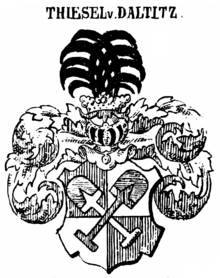Thiesel from Daltitz
Thiesel von Daltitz also Thüsel , Thüssel , Tiesel , Tießel , Tüsel or Tyßl , as well as von Taltitz is the name of an extinct Prussian , originally Vogtland noble family .
history
The sex has its origin in the Vogtland, is called after the local Taltitz . From there the family spread to Bohemia , where until 1599 the village and Gut Neusattl in the Elbogen rule was owned by Jobst Tyßl von Daltitz. Before this it was owned by Sebastian Thüssel von Daltitz together with Wintersgrün (1523). The family was also able to spread to Silesia . Johann Balthasar von Tießel and Taltitz exchanged his estate Mühlbach after 1670 with Kromlau (both in the Duchy of Sagan ) and sold it to Ludwig August von der Lochau before November 1707 . Other estates existed in Silesia at the old and new show (if applicable) near Freystadt .
The family moved to Samland around 1550 . Here the captain Sebastian Thiesel of Daltitz was in 1523 with the manor Powayen invested , which consistently in the family remained. The main line, which died out in 1720, was owned by Powayen (with the family until 1727) and Kukehnen (with the family until 1752) in the parish of Zinten , a branch line was wealthy in Marklack . Several sons are known from the Schönrade line in the Heiligenbeil district , most recently Carl Heinrich Thiesel von Daltitz, 1743 cadet at the cadet house in Berlin , who denied an officer career in the Prussian army . His sister, Helene Charlotte Thiesel von Daltitz († November 2, 1822), married majoress von Bültzingslöwen , decided the tribe in Prussia .
In East Prussia there were Cammershöfen (Kämmershöfen), Domlitten, Klimken , Schönforst / Schönfürst and Wesselshöfen in the district of Heiligenbeil, Dombrowken (1727) and Thieselswalde (1563–1727) in the district of Oletzko , Petermanns in the district of Rastenburg , and Erkritten, Medenau , Mossehnen (1725) , Transau and finally Wickiau in the Fischhausen district in family ownership .
coat of arms
The coat of arms is square in red and silver and covered with two spades placed in the St. Andrew's cross , with the blue irons turned upwards , the handles and handles of which have mixed up tinging . On the helmet with the red and silver blankets a bush of black cock feathers.
literature
- Ernst Heinrich Kneschke (ed.): New general German nobility lexicon . Volume 9, Leipzig 1870, pp. 189-190
Web links
Individual evidence
- ↑ a b c George Adalbert von Mülverstedt , Adolf Matthias Hildebrandt : J. Siebmacher's large and general Wappenbuch , VI. Volume, 4th division, Dead Prussian nobility: Province of Preussen , Bauer & Raspe, Nuremberg 1874, p. 96, Tfl. 70.
- ^ A b Leopold von Ledebur : Adelslexicon of the Prussian monarchy . Volume 3, Berlin 1858 p. 14.
- ↑ a b c Leopold von Zedlitz-Neukirch : New Prussian Adels Lexicon , Volume 4, Leipzig 1837, p. 17.
